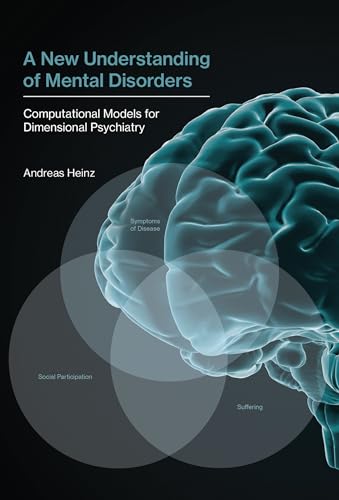A New Understanding of Mental Disorders: Computational Models for Dimensional Psychiatry (Mit Press) - Hardcover

Synopsis
A new computational and dimensional approach to understanding and classifying mental disorders: modeling key learning and decision-making mechanisms across different mental disorders.
Even as researchers look for neurobiological correlates of mental disorders, many of these disorders are still classified solely according to the manifestation of clinical symptoms. Neurobiological findings rarely help diagnose a specific disease or predict its outcome. Although current diagnostic categories are questionable (sometimes labeling common states of human suffering as disorders), traditional neuroimaging approaches are not sophisticated enough to capture the neurobiological markers of mental disorder. In this book, Andreas Heinz proposes a computational and dimensional approach to understanding and classifying mental disorders: modeling key learning and decision-making mechanisms across different mental disorders. Such an approach focuses on the malleability and diversity of human behavior and its biological underpinnings.
Heinz explains basic learning mechanisms and their effects on human behavior, focusing not on single disorders but on how such mechanisms work in a multitude of mental states. For example, he traces alterations in dopamine-reinforcement learning in psychotic, affective, and addictive disorders. He investigates to what extent these basic dimensions of mental disorders can account for such syndromes as craving and loss of control in addiction, positive and negative mood states in affective disorders, and the altered experience of self and world associated with psychotic states. Finally, Heinz explores the clinical and therapeutic implications of such accounts. He argues that a focus on learning mechanisms, with its emphasis on human creativity and resilience, should help reduce the stigma of mental disorder.
"synopsis" may belong to another edition of this title.
About the Author
Andreas Heinz is Director and Chair of the Department of Psychiatry and Psychotherapy at the Charité— Universitätsmedizin Berlin.
"About this title" may belong to another edition of this title.
Search results for A New Understanding of Mental Disorders: Computational...
A New Understanding of Mental Disorders: Computational Models for Dimensional Psychiatry (Mit Press)
Seller: Bellwetherbooks, McKeesport, PA, U.S.A.
hardcover. Condition: Fine. LIKE NEW!!! Has a red or black remainder mark on bottom/exterior edge of pages. Seller Inventory # MIT-HCD-LN-0262036894
A New Understanding of Mental Disorders: Computational Models for Dimensional Psychiatry (Mit Press)
Seller: Midtown Scholar Bookstore, Harrisburg, PA, U.S.A.
hardcover. Condition: Very Good. With very good dust jacket. Very Good hardcover with light shelfwear - NICE! Standard-sized. Seller Inventory # mon0000274417
A New Understanding of Mental Disorders: Computational Models for Dimensional Psychiatry (Mit Press)
Seller: HPB-Diamond, Dallas, TX, U.S.A.
hardcover. Condition: Very Good. Connecting readers with great books since 1972! Used books may not include companion materials, and may have some shelf wear or limited writing. We ship orders daily and Customer Service is our top priority! Seller Inventory # S_446598672
New Understanding of Mental Disorders : Computational Models for Dimensional Psychiatry
Seller: GreatBookPrices, Columbia, MD, U.S.A.
Condition: As New. Unread book in perfect condition. Seller Inventory # 29142561
A New Understanding of Mental Disorders
Seller: PBShop.store UK, Fairford, GLOS, United Kingdom
HRD. Condition: New. New Book. Shipped from UK. Established seller since 2000. Seller Inventory # GB-9780262036894
Buy New
Quantity: 4 available
New Understanding of Mental Disorders : Computational Models for Dimensional Psychiatry
Seller: GreatBookPrices, Columbia, MD, U.S.A.
Condition: New. Seller Inventory # 29142561-n
A New Understanding of Mental Disorders (Hardcover)
Seller: Grand Eagle Retail, Bensenville, IL, U.S.A.
Hardcover. Condition: new. Hardcover. A new computational and dimensional approach to understanding and classifying mental disorders- modeling key learning and decision-making mechanisms across different mental disorders.Even as researchers look for neurobiological correlates of mental disorders, many of these disorders are still classified solely according to the manifestation of clinical symptoms. Neurobiological findings rarely help diagnose a specific disease or predict its outcome. Although current diagnostic categories are questionable (sometimes labeling common states of human suffering as disorders), traditional neuroimaging approaches are not sophisticated enough to capture the neurobiological markers of mental disorder. In this book, Andreas Heinz proposes a computational and dimensional approach to understanding and classifying mental disorders- modeling key learning and decision-making mechanisms across different mental disorders. Such an approach focuses on the malleability and diversity of human behavior and its biological underpinnings.Heinz explains basic learning mechanisms and their effects on human behavior, focusing not on single disorders but on how such mechanisms work in a multitude of mental states. For example, he traces alterations in dopamine-reinforcement learning in psychotic, affective, and addictive disorders. He investigates to what extent these basic dimensions of mental disorders can account for such syndromes as craving and loss of control in addiction, positive and negative mood states in affective disorders, and the altered experience of self and world associated with psychotic states. Finally, Heinz explores the clinical and therapeutic implications of such accounts. He argues that a focus on learning mechanisms, with its emphasis on human creativity and resilience, should help reduce the stigma of mental disorder. A new computational and dimensional approach to understanding and classifying mental disorders: modeling key learning and decision-making mechanisms across different mental disorders. Shipping may be from multiple locations in the US or from the UK, depending on stock availability. Seller Inventory # 9780262036894
A New Understanding of Mental Disorders - Computational Models for Dimensional Psychiatry
Seller: Books Puddle, New York, NY, U.S.A.
Condition: New. Seller Inventory # 26375202190
A New Understanding of Mental Disorders
Seller: Rarewaves USA, OSWEGO, IL, U.S.A.
Hardback. Condition: New. Seller Inventory # LU-9780262036894
A New Understanding of Mental Disorders - Computational Models for Dimensional Psychiatry
Seller: Majestic Books, Hounslow, United Kingdom
Condition: New. Seller Inventory # 371891793
Buy New
Quantity: 3 available
